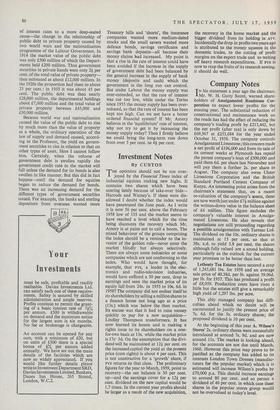Investment Notes
By CUSTOS HE optimists should not be too over-
joyed by the Financial Times index of industrial equities making new highs. It contains two shares which have been soaring lately because of take-over bids— Harrods and Watney's. If these were dis- allowed I doubt whether the index would have penetrated the June peak. As I write it is now 56 per cent. above the February 1958 low of 155 and the market seems to have reached a level which for the time being discounts the recovery which Mr. Amory is at pains not to call a boom. The mixed behaviour of the groups comprising the index should be a reminder to the in- vestor of the golden rule—never enter the market blindly but always selectively. There are always some industries or some companies which are not conforming to the index. Who would have thought, for example, that PYE, a leader in the elec- tronics and radio-television industries, would have suffered a 50 per cent. drop in earnings and seen the market price of its equity fall from 24s. in 1955 to 10s. 6d. in 1958? The company did not endear itself to its shareholders by selling a million shares to a finance house not long ago at a price (13s.) which was below the then market. Its excuse was that it had to raise money quickly to pay for a new acquisition— Lindley Thompson transformers. It has now learned its lesson and is making a rights issue to its shareholders on a one- for-two basis at 13s. while the market price is 17s. 3d. On the assumption that the divi- dend will be maintained at 12} per cent. on the increased capital the yield at the present price (cum rights) is about 4 per cent. This is not unattractive for a 'growth' share, if PYE returns to that class. The preliminary figures for the year to March, 1959, point to recovery—the net balance is 30 per cent. up—and the earnings cover for a 121 per cent. dividend on the new capital would be 1.7 times. In the current year profits should be larger as a result of the new acquisition, the recovery in the home market and the bigger dividend from its holding in ATV. Incidentally the drop in profits two years ago is attributed to the money squeeze in the domestic trades, to the cutting of profit margins on the export trade and to writing off heavy research expenditures. If PYE is now to reap the fruits of its research sowing, it should do well.






































 Previous page
Previous page